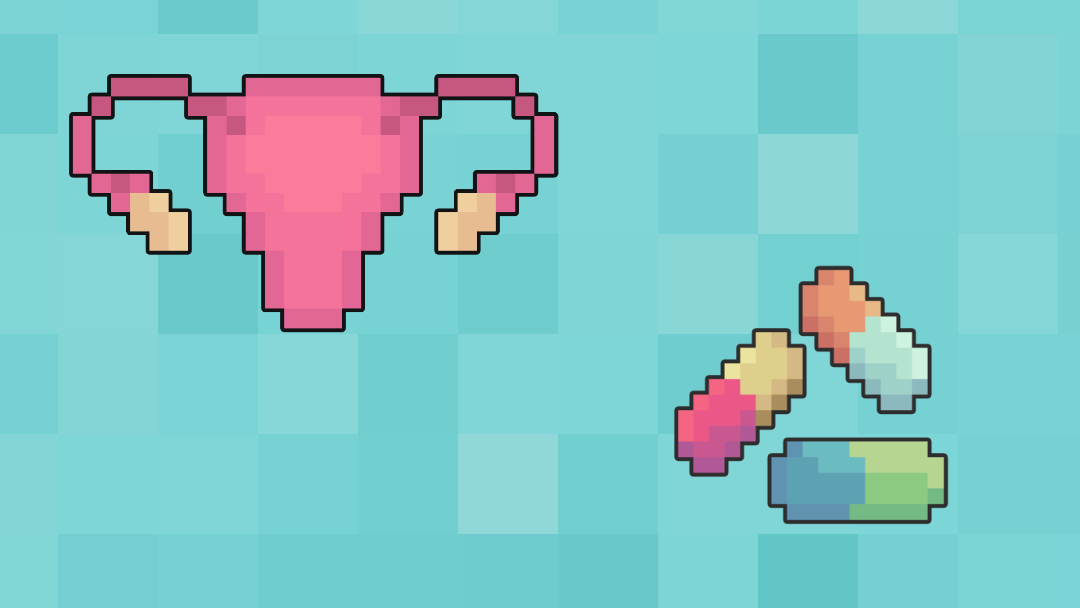- 📖 Geeky Medics OSCE Book
- ⚡ Geeky Medics Bundles
- ✨ 1300+ OSCE Stations
- ✅ OSCE Checklist PDF Booklet
- 🧠 UKMLA AKT Question Bank
- 💊 PSA Question Bank
- 💉 Clinical Skills App
- 🗂️ Flashcard Collections | OSCE, Medicine, Surgery, Anatomy
- 💬 SCA Cases for MRCGP
To be the first to know about our latest videos subscribe to our YouTube channel 🙌
Contraceptive counselling often features in OSCEs and it’s therefore important to be familiar with the various types of contraception available. This article focuses on counselling patients about the progesterone-only pill (POP) including the common questions patients ask, the answers you’ll be expected to articulate and how best to structure the consultation.
Opening the consultation
Wash your hands and don PPE if appropriate.
Introduce yourself to the patient including your name and role.
Confirm the patient’s name and date of birth.
Check the patient’s understanding of the types of contraception available.
Explore the reasons why the patient wants the POP.
Ideas, concerns and expectations
It is important to explore the patient’s ideas, concerns and expectations early in the consultation, as you may need to correct any misconceptions about the POP and address the patient’s concerns. When exploring concerns, it is important to do so in a sensitive and honest manner.
It’s also important to clarify the patient’s expectations of the POP because if these are unrealistic, other forms of contraception may be better able to meet their needs.
Ideas
Explore what the patient currently understands about the POP:
- “Have you heard of the progesterone-only pill?”
- “What do you already know about the progesterone-only pill?”
Concerns
Ask if the patient has any concerns about the POP:
- “Is there anything that worries you about the progesterone-only pill?”
Expectations
Explore the patient’s expectations of the POP:
- “What are you hoping the progesterone-only pill can do for you?”
- “Why do you think the progesterone-only pill is the best choice for you?”
What is the progesterone-only pill?
Using patient-friendly language, explain that the progesterone-only pill contains the hormone progesterone. Explain that different POPs contain different types of progesterone.
“The progesterone-only pill, sometimes called the mini-pill, is a type of contraceptive pill that contains a hormone called progesterone. This hormone is almost exactly the same as the natural hormone that is produced by your ovaries.” ¹
What are the different types of POP?
Explain to the patient that there are three main types of POP in the UK, each containing different forms of progesterone:
- Norethisterone
- Levonorgestrel
- Desogestrel
Levonorgestrel can also be used as emergency contraception.
How does the progesterone-only pill work?
The POP prevents conception by inhibiting ovulation, thickening cervical mucus, and thinning the endometrium to prevent implantation of the blastocyst. ²
“The main action of desogestrel is that it stops you from getting pregnant by stopping your ovaries from producing an egg every month. Other types of POP will sometimes stop you from producing an egg.”
“The POP also works by thickening the mucus around your cervix which stops sperm from entering your womb.”
“The POP can also make the lining of your womb thinner which would prevent a fertilised egg from being accepted.”
How effective is the progesterone-only pill?
Patients understandably want to know how effective contraception is and this is often a major factor in their decision as to which type of contraception they want to use. As a result, it’s useful to know some basic statistics on efficacy. However, if you’re unsure, signpost the patient to a reliable source and don’t guess!
Explain to the patient that the effectiveness of the pill depends on compliance. However, if the POP is used correctly, it is 99% effective. ¹
“If you take the progesterone-only pill at the appropriate time each day and don’t miss pills, it is 99% effective at preventing pregnancy.”
Pros and cons of the progesterone-only pill
Always give patients as much information as possible so that they can make an informed decision. It is useful to do this by discussing the pros and cons of the POP.
“If it is okay with you, I’d like to tell you about the benefits and disadvantages of the pill, then hopefully you will have enough information to make a decision”
Advantages of the POP
Non-invasive method
“Taking the pill does not require an invasive procedure like some other forms of contraception.”
Effective contraception
“The pill is 99% effective when taken correctly.”
Problems associated with periods improve
“Your periods may become more regular, lighter and less painful.”
Useful if oestrogens can’t be taken
“The POP is useful if you can’t take oestrogen-containing medications such as the combined oral contraceptive pill.”
Safe during breastfeeding
“The POP will not harm your baby if you choose to breastfeed.”
Disadvantages of the POP
Side effects
“To start off with, you may experience some side effects such as a headache, nausea, mood changes or breast tenderness.” ¹
Change in periods
“When you take the POP, your periods may change. You may experience irregular, light or more frequent periods. Your periods could also stop completely.” ¹
Protection from STIs
“Unfortunately, the pill does not protect you from sexually transmitted infections.”
User dependent
“It is important that you remember to take the pill at the same time every day. Sometimes it is helpful to set a reminder on your phone or in your diary.”
Risks of the POP
It is important to explain the risks of taking the pill so that the patient is aware and can make an informed decision.
Ovarian cysts
“Sometimes women who use the POP may develop small cysts on their ovaries.”
“These cysts are not dangerous and often disappear without any treatment.”
Breast cancer
“Research has shown that there is a small increase in the risk of breast cancer compared to people who are taking non-hormonal contraception.”
Contraindications of the POP ²
A patient should not take the POP if they:
- are pregnant
- have breast cancer
- have severe liver cirrhosis
- have liver tumours
Starting the pill and missed pills
This section of the consultation can be quite confusing for the patient. It is therefore important to explain this in a patient-friendly manner, check understanding at regular intervals and invite questions at the end.
Starting the pill
“You can start the progestogen-only pill at any time in your menstrual cycle if you are sure you are not pregnant.”
“If you start it on day 1 to 5 of your menstrual cycle (the first 5 days of your period), it’ll work straight away and you’ll be protected against pregnancy. You will not need additional contraception.”
“If you have a short menstrual cycle, you’ll need additional contraception, such as condoms, until you’ve taken the pill for 2 days.”
“If you start the progestogen-only pill on any other day of your cycle, you will not be protected from pregnancy straight away and will need additional contraception until you’ve taken the pill for 2 days.”
Missed pills
If one pill is missed or a new pack is started more than three hours* late ¹
“Take the missed pill straight away, if you have missed more than one pill, only take one pill.”
“Take the next pill at the usual time you would take it, this might mean you have to take two pills in one day. Don’t worry, this is not harmful.”
“Unfortunately, you are not protected from pregnancy and therefore you should use condoms for the next two days. Continue to take your pills as you normally would.”
“If you have had sex in the same time period that you also missed your pill, you may need to seek advice for emergency contraception.”
If one pill is missed less than three hours* late
“Take the pill as soon as you remember to take it and then take your next pill at the usual time you would take it. You will then be protected from pregnancy.”
*12 hours if it is the desogestrel progesterone-only pill
Closing the consultation
Summarise the key points back to the patient.
Ask the patient if they have any further questions or concerns that haven’t been addressed.
Throughout the consultation you should check the patient’s understanding at regular intervals, using phrases such as “Can you just repeat back to me what we’ve just discussed regarding…”.
It may also be useful to direct the patient to any websites or leaflets with further information.
Offer the patient time to consider their decision.
Encourage the patient to use condoms if they are not currently using contraception.
Thank the patient for their time.
Dispose of PPE appropriately and wash your hands.
Common patient questions
Below are some common questions that patients may have regarding the progesterone-only pill. Sometimes, in an OSCE situation, they may ask you one or two questions at the end of your consultation. Having a good answer can be useful in demonstrating to the examiner that you have a solid understanding of the topic.
What happens if the patient is sick or have diarrhoea?
If the patient is sick within two hours of taking the pill then they will need to take another one if they are feeling better.
If a patient has severe diarrhoea for more than 24 hours, they will need to take the pill as if they missed a pill and follow the instructions. This should continue until the diarrhoea is no longer severe.
Which common medicines affect the efficacy of the pill?
Explain to the patient that they should make the person prescribing the pill aware of what medications they are taking so the prescriber can identify any medications which might affect the pill.
“Some medicines such as some epilepsy medication, HIV medication and St John’s Wort can reduce the levels of contraceptive hormones and therefore reduce the effectiveness of the contraception.”
What should the patient do if they want to try and become pregnant?
Patients are usually advised to stop taking the pill at the end of a pack and wait until after their first natural period before trying to become pregnant. Don’t forget to advise the patient on pre-pregnancy care such as folic acid and smoking cessation.
What should the patient do if they want to stop taking the pill?
Patients are usually advised to stop taking the pill at the end of a pack. However, if they cannot wait, it is important to offer information about alternative contraception to prevent pregnancy.
Can the patient take the POP after having a baby?
Patient’s can take the POP from any time after birth. If the POP is started after day 21, advise them to use condoms for two days.
References
- NHS. Progesterone-only Pill. Available at: [LINK].
- Harding, M. (2014). Progestogen-only Contraceptive Pill. Patient.info. Available at: [LINK].




